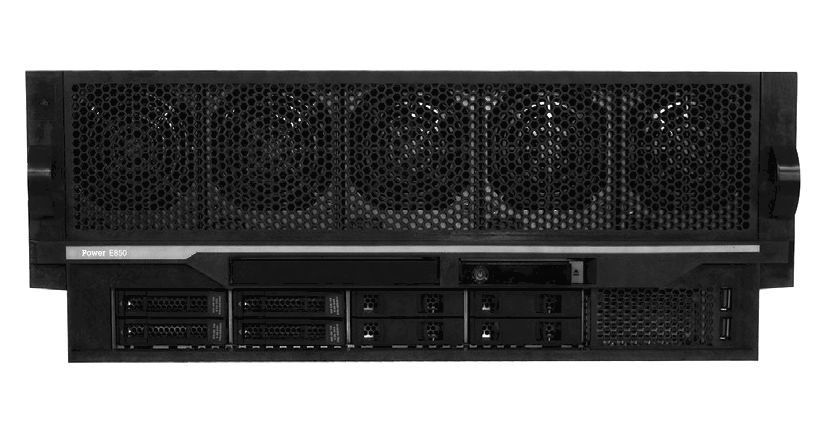
In the absence of Power8+ processor upgrades this year, and with sales of midrange systems taking a bit of a hit in the third quarter, IBM has to do something to push its iron against Xeon E7 and Sparc M7 systems between now and when the Power9 machines are available in the second half of 2017. It also needs to entice customers who are on older Power7 and Power7+ machinery to upgrade now rather than wait the better part of a year to spend money.
To that end, IBM has launched the Power 850C four-socket server, a companion to the high-end NUMA Power E870C and Power E880C systems that the company debuted a few weeks ago. The C in these machines is meant to designate “cloud,” of course, but what it really signifies is an update to the midrange and high-end of the Power Systems line that is a kind of virtual Power8+ upgrade, providing the bump in price/performance that a processor upgrade and system refresh normally does every 18 months or so in the Power line without having to go through the hassle of etching an updated Power8+ chip and certifying it in existing platforms. The C-style machines also deploy DDR4 memory, which saves a bit on power and, with lower prices than existing DDR3 modules, also helps bring down the overall cost of the systems.
Big Blue announced the Power E850 server back in May 2015, with three different processor options on the system: an eight-core running at 3.7 GHz, a ten-core running at 3.35 GHz, and a twelve-core running at 3 GHz. These original Power8 processors were etched in a 22 nanometer process and they had a 190 watt thermal envelope. The Power E850 systems shipped with DDR3 main memory, which topped out at 2 TB across four sockets.
The chips used in the Power E850 systems are also made using 22 nanometer processes from Globalfoundries and run a bit hot compared to Intel’s “Broadwell” Xeon E7-4800 v4 server motors, which debuted in June of this year for four-socket iron and which peak at 165 watts running at 2.2 GHz with 24 cores and at 2.8 GHz with ten cores. The Xeon E5-4600 v4 processors, also of Broadwell lineage and also aimed at four-socket machines, came out in July. They have one fewer QuickPath Interconnect port, which means less efficient NUMA scaling across the sockets, but they allow for denser server designs because they use standard DDR4 memory sticks instead of buffered memory like both the Xeon E7 and Power8 chips use. The Xeon E5-4600 v4 chips deliver ten cores running at 2.6 GHz or 18 or 22 cores running at 2.2 GHz within a 135 watt thermal envelope. Those relatively lower thermals are possible because the Broadwell chips are etched in a 14 nanometer process and Intel gears down the clock speeds a lot lower than Big Blue does on the Power8s. IBM is going after the customers who want the highest throughout and memory bandwidth and it is not trying to shoot it out and lose money on every deal it does. (Although the company’s chief financial officer, Martin Schroeter, was perfectly clear that margins were under pressure on entry and midrange machines in the Power Systems line in the third quarter.)
Four-socket machines are selling well as boxes to support large numbers of virtual machines or fairly large databases on a single machine, and are particularly useful for running SAP HANA and other in-memory databases and data stores. For many customers in the enterprise, such machines are their primary systems, running ERP, CRM, and other application software and related databases, and in certain cases where fat memory is required on nodes, four-socket boxes are used to create clusters to run simulations and models. They also have one other important characteristic: Four-socket machines have much juicier margins than two-socket boxes.
Knowing this, IBM has to get an improved four-socket Power Systems machine in the field, and the Power E850C is that machine. George Gaylord, offering manager for Power Systems at IBM, tells The Next Platform that Power E850C has modified motherboards, I/O planars, power supplies, and cooling that allows the Power8 processors to run hotter, up to 250 watts each and a 31.6 percent increase in heat. With that higher thermal envelope, the Power8 chips in the Power E850C run at higher clock speeds than those in the Power E850., with the eight-core Power8 used in the Power E850C running at 4.22 GHz instead of 3.72 GHz , up 13.4 percent; the ten-core variant running at 3.95 GHz instead of 3.35 GHz, up 17.9 percent, and the twelve-core variant running at 3.65 GHz instead of 3.02 GHz, up 20.9 percent. (The math in the chart below is a little different from what our trust HP-12C calculator shows on the clock speed increase – go figure.)
Here’s the fun bit. The new Power E850C systems also allow for overclocking when other components of the system leave them thermal capacity, and eight-core chips can actually push up into the 4.32 GHz zone, their ten-core can push up to 4.12 GHz, and the twelve-core can push up to 3.82 GHz. Such clock speeds give IBM as much as a 26.5 percent improvement in performance for that 31.6 percent increase in heat. This is a trade that many of IBMs customers – including some that are new to the platform – are willing to make. Having 48 cores with eight threads per core running at 3.82 GHz is a lot of throughput, and a machine with 4 TB of memory (doubled up with the move to DDR4 chips for “Centaur” buffered CDIMM memory made by IBM, can probably sustain that compute at a high percentage of utilization on a lot of workloads.
The Real Target For New Power Is Old Power
While everyone likes a good fight and competition is good for customers even if it causes heartburn (and lower margins) for IT suppliers, the real target for the new Power E850C machines – or, more precisely, the easiest targets – are customers who have older Power6, Power7, and Power7+ machines and who want to add more capacity than their current systems have. And because IBM and its partners tier software based on the model size, in a rough sense, there is a possibility that software could be a lot less expensive on an E850C than an older Power 570 or Power 595 based on Power6 or Power6+ chips or an old (but more recent) Power 770 or 770+ machine based on Power7 or Power7+ chips.
Here are how the performance figures stack up with the old and new iron, and how the Power E850C compares to the bigger Power E870C system that was announced a month ago:
The chart above shows the Relative Performance (rPerf) ratings of each processor type in a fully loaded system for the Power 770, Power 770+, Power E850C, and Power E870C. (rPerf is loosely based on the TPC-C online transaction processing benchmark test, and is used by IBM to gauge the performance of each processor feature, with its unique core count and clock speeds, across the entire Power Systems line for AIX and Linux workloads.)
The Power 750 and its successors, the Power 850 and Power 850C, are single-node, four-socket machines. To make larger systems, IBM has extended NUMA ports that allow for multiple four-socket nodes to be glued together to create machines with eight, twelve, or sixteen sockets; this architecture was based on Sequent technology that IBM acquired in 1999, if you remember, and was first commercialized with the Power5-based Power 570 systems back in the summer of 2004. (The Power 595 and Power 795 machines had a more monolithic design and scaled to 32 sockets in a single image with a much bigger memory footprint, but Big Blue did not build such a behemoth with the Power8 chips, focusing instead on a much more efficient sixteen-socket box.)
As you can see from the chart above, the four-node Power 770 and Power 770+ NUMA systems can be replaced easily with a single node Power E850C with the goosed Power8 processors. This is a huge factor of compaction, and considering that software fees, maintenance, power, and cooling are also lower on the Power E850C, IBM should be able to convince many customers to downshift box sizes and boost performance at the same time.
Like other high-end machines in the Power Systems line, the Power E850C has capacity on demand utility pricing for cores and main memory, which can be activated in stages or intermittently rather than all at once when the machine is first deployed. The Power E850C uses DDR4 memory, but IBM is keeping the performance the same at 1.6 GHz and using the memory to make less expensive memory cards and pass on the savings to customers. (We think that if customers wanted faster 2.4 GHz DDR4 CDIMM memory cards to match their overclocked Power8 processors, then IBM would be happy to supply them on a custom basis.) IBM has cut the price of base memory cards for the Power E850C by between 20 percent and 50 percent compared to the DDR3 cards used in the Power E850, but it still costs $35 per GB to activate memory chunks. IBM has a special Solution Edition for HANA that has lower-cost core activations and even lower priced 1 TB memory (expandable to 3 TB or 4 TB) to take on the Xeon E7 for SAP HANA in-memory workloads.
Like the other C-style Power Systems machines, the Power E850C includes a freebie license to IBM’s PowerVM Enterprise Edition, which is the top-end version of its virtualization hypervisor. IBM is also tossing in a year’s worth of capacity for a single-socket, bare metal Power8 server on the SoftLayer cloud (which runs PowerKVM, not PowerVM, if you want to virtualize it). The C-style bundles also include IBM’s PowerVC implementation of OpenStack and a software maintenance contract that provides 24×7 coverage at the cost of 9×5 business coverage; both of these are priced separately. Here are how the features stack up and the resulting price/performance, including what IBM considers typical discounts:
All in, the Power E850C as configured above with ten-core Power8 processors offers about 13 percent more performance than a Power E850 at a 12 percent lower system price (including a 20 percent discount on both machines after they are configured up). That works out to a 21 percent price/performance improvement.
It would be interesting to configuring this Power E850C machine up with Linux and see how it compares to Xeon E5-4600 and Xeon E7-4800 boxes, and we will set about doing just that. Comparisons between the new Power Systems LC iron and Xeon E5-2600 systems also seems to be in order.

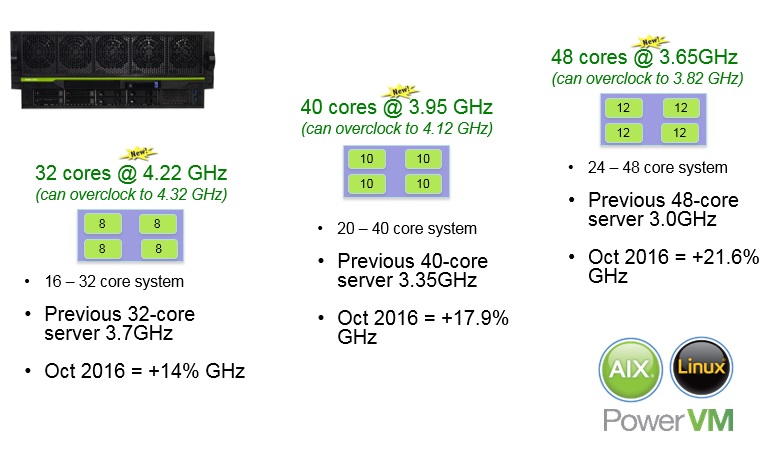
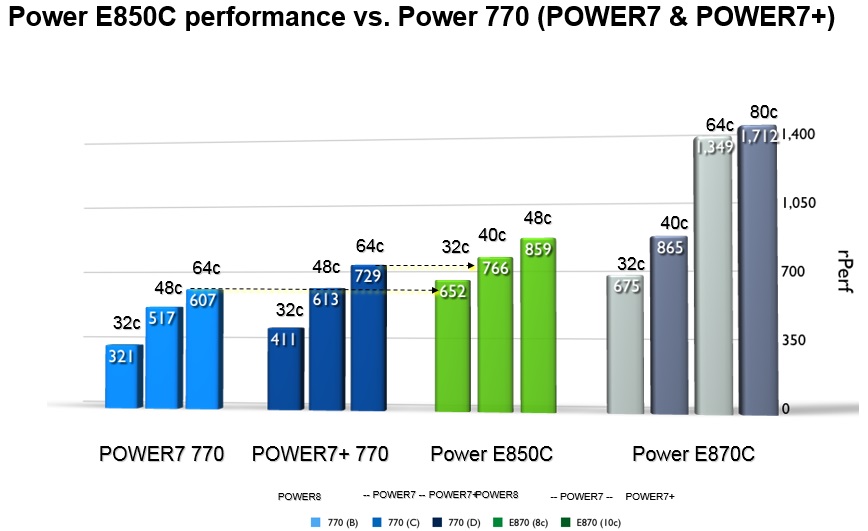
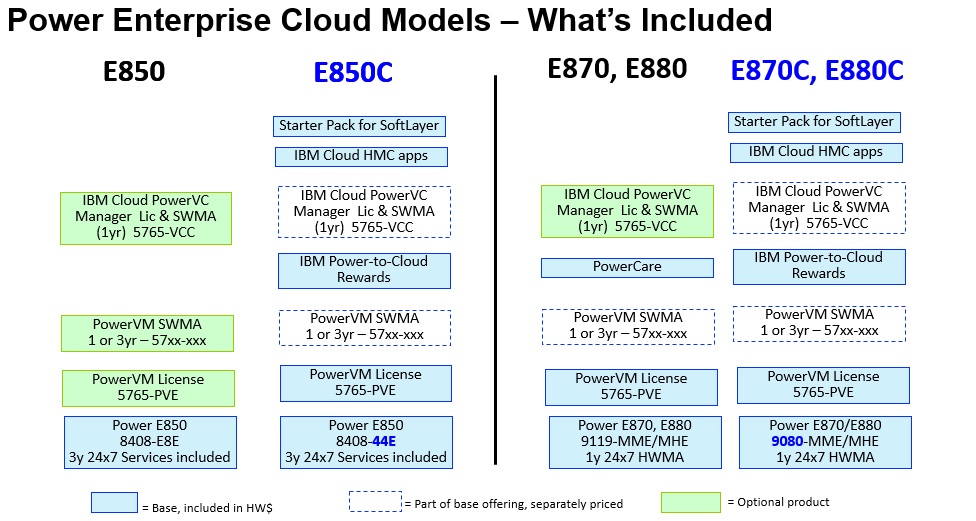
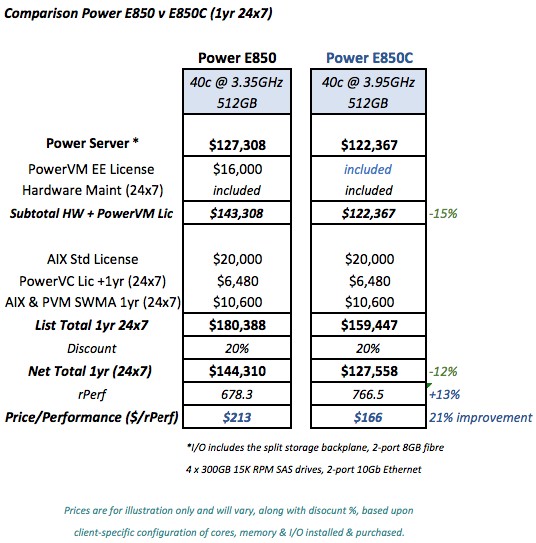

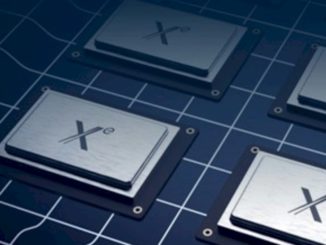

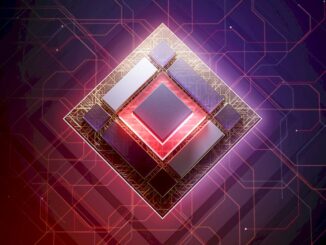
“…It would be interesting to configuring this Power E850C machine up with Linux and see how it compares to Xeon E5-4600 and Xeon E7-4800 boxes…”
Well, here they do that. And it’s not a pretty sight. IBM POWER8 lags behind in every benchmark vs Intel Xeon.
http://www.anandtech.com/show/10539/assessing-ibms-power8-part-2-server-applications/8
LOL, andatech.com = inteltech.com
Don’t quote them when you are comparing different vendors. They just adjusted the benchmarks to make Broadwell looks better.
It is clearly vissible on power comsuption. Last year when they were comparing Haswells vs POWER8, Haswell has clearly better perf/watt than POWER.
But this year they adjusted it to make Broadwell on top of everything even when Haswell falls under POWER8 (same POWER8 they beated last year). This is pretty ridiculous.
Here is the page from the first part of the 2 part seriesof articles that you did not link to, and we have a 10 core power8 processor tested against a 22 core Intel processor, so some things are not equal there. The Power8 has 80 total processor threads(SMT8) while the Intel Xeon has 44 processor threads(SMT2). I would not call this an apples to apples comparison for the most part as I would rather see the core counts the same and maybe the IBM power8 cores set to run in SMT2 mode for some testing regimens! The software stack needs a little more time to mature up also as there are still issues with the testing that AnandTech was able to do. Your only quoting the limited benchmarks and not noting other hardware differences leads me to believe that you have some sort of agenda, but I do not place much value in the AnandTech results done at that time or the hardware chosen to compare. Make note of the fab process node between the IBM Power8(22nm SOI) tested and the Intel Xeon SKU(14nm finfet), and the power8 is a much wider superscalar design than the Xeon with the power8 core able to handle 8 processor threads per core dynamically from 2 to 8 threads per core.
“System Specs”
http://www.anandtech.com/show/10435/assessing-ibms-power8-part-1/5
Silly person having more threads per core is quite definitely not the same has having more cores..
Is there any architecture that is able to use 8 threads per core efficiently?? Non exist except for POWER8 it really is amazing. The fact that a 8-way superscalar architecture using an ancient non-finfet 22nm can clock at 3.85Ghz with 12 cores at even at 250 TDP is nothing short of a miracle..
good point. A 10 core power8 using 22nm tech is similar to a 22 core intel using 14nm tech, plus probably far less optimized software stack.That tells a lot of the architecture design of intel (they are just adding cores as technology scales, small progression –if any– on single thread performanc). Now that intel is loosing the technology advantage…that make IBM (and third party) processors a very real threat to Intel. Google saw this. POWER9 will be a real thing with the new microarhicteture optimized for the cloud and big data.